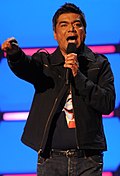Portal:Hispanic and Latino Americans
Welcome to the Hispanic and Latino Americans portalHispanic and Latino Americans (Spanish: Estadounidenses hispanos y latinos; Portuguese: Estadunidenses hispânicos e latinos) are Americans of Spanish and/or Latin American background, culture, or family origin. These demographics include all Americans who identify as Hispanic or Latino regardless of race. As of 2020, the Census Bureau estimated that there were almost 65.3 million Hispanics and Latinos living in the United States and its territories. "Origin" can be viewed as the ancestry, nationality group, lineage or country of birth of the person or the person's parents or ancestors before their arrival in the United States of America. People who identify as Hispanic or Latino may be of any race, because similar to what occurred during the colonization and post-independence of the United States, Latin American countries had their populations made up of descendants of white European colonizers (in this case Portuguese and Spaniards), Native peoples of the Americas, descendants of African slaves, post-independence immigrants coming from Europe, Middle East and East Asia, as well as descendants of multiracial unions between these different ethnic groups. As one of the only two specifically designated categories of ethnicity in the United States, Hispanics and Latinos form a pan-ethnicity incorporating a diversity of inter-related cultural and linguistic heritages, the use of the Spanish and Portuguese languages being the most important of all. Most Hispanic and Latino Americans are of Mexican, Puerto Rican, Cuban, Salvadoran, Dominican, Colombian, Guatemalan, Honduran, Ecuadorian, Peruvian, Venezuelan or Nicaraguan origin. The predominant origin of regional Hispanic and Latino populations varies widely in different locations across the country. In 2012, Hispanic Americans were the second fastest-growing ethnic group by percentage growth in the United States after Asian Americans. (Full article...) Selected articleHow the García Girls Lost Their Accents is a 1991 novel written by Dominican-American poet, novelist, and essayist Julia Alvarez. Told in reverse chronological order and narrated from shifting perspectives, the text possesses distinct qualities of a bildungsroman novel. Spanning more than thirty years in the lives of four sisters, the story begins with their adult lives in the United States and ends with their childhood in the Dominican Republic, from which their family was forced to flee due to the father’s opposition to Rafael Leónidas Trujillo's dictatorship. The novel's major themes include acculturation and coming of age. It deals with the myriad hardships of immigration, painting a vivid picture of the struggle to assimilate, the sense of displacement, and the confusion of identity suffered by the García family, as they are uprooted from familiarity and forced to begin a new life in New York City. The text consists of fifteen interconnected short stories, each of which focuses on one of the four daughters, and in a few instances, the García family as a whole. Although it is told from alternating perspectives there is particular focus throughout the text on the character of Yolanda, who is said to be the both the protagonist and the author's alter ego. (more...) Selected imageDid you know...
July/August 2014 Things you can do
Selected biography Lopez was born in Mission Hills, Los Angeles, California, of Mexican descent. He was deserted by his father when he was two months old and by his mother when he was 10 years old, then was raised by his maternal grandmother, Benita Gutierrez, a factory worker, and step-grandfather, Refugio Gutierrez, a construction worker. Lopez attended San Fernando High School, graduating in 1979. (more...) SubcategoriesRelated PortalsAssociated WikiProjects
Hispanic and Latino American TopicsAfro-Latin American | Asian Hispanic and Latino Americans | Black Hispanic and Latino Americans | Californio | Chicano | Cuban American | Demographics of Hispanic and Latino Americans | Hispanic | Hispanic Americans in World War II | Hispanic and Latino Americans | Hispanic–Latino naming dispute | Hispanos | Latino | List of Hispanic and Latino Americans | MEChA | Mexican American | Puerto Rican people | Spanish language in the United States | Tejano | White Hispanic and Latino Americans Associated WikimediaThe following Wikimedia Foundation sister projects provide more on this subject:
Discover Wikipedia using portals |























